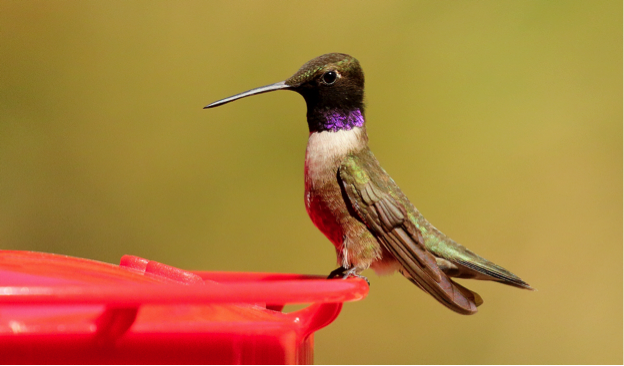By Bob Walker
Our second most common hummingbird of summer is the Black-chinned Hummingbird (Archilochus alexandri). This very adaptable hummingbird breeds almost anywhere along the U.S. Rocky Mountains from Mexico to Canada, and is mostly found in riparian areas at the southern end of its summer range. It winters along the west coast of Mexico, with some sparse populations wintering along the U.S. Gulf Coast. In the Los Alamos area, they seem to prefer lower elevations (i.e. White Rock) to the higher elevation areas of Los Alamos and the mountains, but they are nevertheless common all across the county.
The male Black-chinned Hummingbird is instantly recognizable by the iridescent violet feathers that form a collar around its lower neck. Non-iridescent black feathers are above the collar. Their backs and head are greenish, and they have a small white eye-spot behind the eye. Females are much less distinctive, mostly birds with green above and white below and with little or no markings on the throat (gorget). Female Black-chinned Hummingbirds females can be distinguished from the other hummingbird species that visit us by their lack of any rufous coloration on their flanks or tails.

Several factors affect the success rate of Black-chinned Hummingbird nesting. Obvious negative factors include bad weather, lack of sufficient food, and nest predators. Interestingly, a positive factor is the proximity of the hummingbird nest to a hawk nest. Because hummingbirds themselves are too small to be targeted by hawks, nests that are constructed in a “cone of protection” below a hawk nest tend to be more successful, because the presence of the hawk discourages predators (like jays) from robbing the nest of its eggs or hatchlings. You might find the article at this link interesting. You can also find more detailed articles about the Black-chinned Hummingbird on these web pages: identify.whatbird.com and allaboutbirds.org
Enjoy more beautiful photos of Black-chinned Hummingbirds at the Alan Murphy and Glenn Bartley web sites. I also have a site with some local images.

